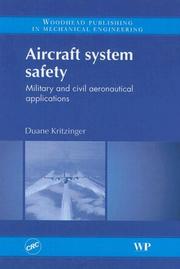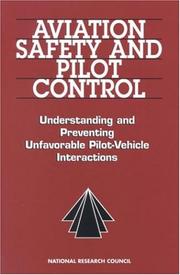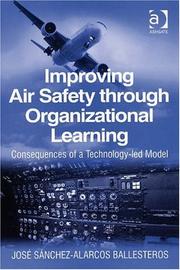
ISBN: 9781845691363 0849390125 1845691369 9786610544400 1280544406 1845691504 9781845691509 9780849390128 9781280544408 6610544409 Year: 2006 Publisher: Cambridge, England Boca Raton Woodhead Pub. CRC Press
Abstract | Keywords | Export | Availability | Bookmark
 Loading...
Loading...Choose an application
- Reference Manager
- EndNote
- RefWorks (Direct export to RefWorks)
Demonstrating safety for the application of ever increasingly complex technologies is always a formidable task. In the event of an accident society want someone to blame. How would your records face up to legal scrutiny and how would you be able to demonstrate that you have taken reasonable care as a professional engineer/manager should you be faced with a court appearance? The problem is that many system engineers do not have the appropriate training; the required safety approaches, tools and techniques; and their managers do not know when and how they may be applied and appropriately resourc
veiligheid --- 629.73 --- luchtvaart --- burgerluchtvaart --- militaire luchtvaart --- luchtvaarttuigen --- Aeronautical engineering. Aircraft --- Aeronautics --- Airplanes --- Aeronautics, Commercial --- Air safety --- Aircraft safety measures --- Aviation safety --- Propellant actuated devices --- Safety measures. --- Design and construction. --- Safety measures

ISBN: 0309056888 9786610210558 1280210559 0309596777 058509098X 9780585090986 9780309056885 0309175089 9780309175081 9781280210556 6610210551 9780309596770 Year: 1997 Publisher: Washington, D.C. : National Academy Press,
Abstract | Keywords | Export | Availability | Bookmark
 Loading...
Loading...Choose an application
- Reference Manager
- EndNote
- RefWorks (Direct export to RefWorks)
TRANSPORTATION --- Aviation / Piloting & Flight Instruction --- Airplanes --- Aeronautics --- Aeronautics Engineering & Astronautics --- Mechanical Engineering --- Engineering & Applied Sciences --- Design and construction --- Human factors --- Piloting --- Safety measures --- Design and construction. --- Human factors. --- Safety measures. --- Aeronautics, Commercial --- Air safety --- Aircraft safety measures --- Aviation safety --- Human factors in airplane piloting --- Propellant actuated devices --- Human engineering
Periodical
ISSN: 19390300 Year: 2002 Publisher: Oklahoma City, Okla. : FAA Academy
Abstract | Keywords | Export | Availability | Bookmark
 Loading...
Loading...Choose an application
- Reference Manager
- EndNote
- RefWorks (Direct export to RefWorks)
Aeronautics --- Aviation psychology --- Aviation psychology. --- Research --- Human factors --- Safety measures --- Human factors. --- Research. --- Safety measures. --- Flight --- Aeronautics, Commercial --- Air safety --- Aircraft safety measures --- Airplanes --- Aviation safety --- Aeronautical research --- Human factors in aeronautics --- Aerostation --- Air navigation --- Aviation --- Psychological aspects --- Psychology --- Psychology, Applied --- Propellant actuated devices --- Human engineering --- Communication and traffic --- Aerodynamics --- Airships --- Astronautics --- Balloons --- Flying-machines

ISBN: 0754649121 9786611099084 1281099082 0754685942 1317118235 1317118243 9780754685944 9781281099082 9780754649120 9781317118237 9781317118244 6611099085 9781315588032 9781317118220 131558803X Year: 2007 Publisher: Aldershot, England Burlington, VT Ashgate
Abstract | Keywords | Export | Availability | Bookmark
 Loading...
Loading...Choose an application
- Reference Manager
- EndNote
- RefWorks (Direct export to RefWorks)
The key theme of this book is organizational learning and its consequences for the field of air safety. Air safety rates have been improving for a long time, demonstrating the effects of a good learning model at work. However, the pace of improvement has almost come to a standstill. Improving Air Safety through Organizational Learning explains this situation as being the consequence of a development model supported chiefly by information technology being introduced as an alternative to human operators, and offers a new development model, one that makes strong use of technology but at the same
Aeronautics. --- Aircraft accidents. --- Organizational learning. --- Aeronautics --- Safety education --- Organizational learning --- Aeronautics Engineering & Astronautics --- Mechanical Engineering --- Engineering & Applied Sciences --- Safety measures --- Safety education. --- Safety measures. --- Learning organizations --- Accidents --- Safety training programs --- Aeronautics, Commercial --- Air safety --- Aircraft safety measures --- Airplanes --- Aviation safety --- Prevention --- Study and teaching --- Learning --- Communities of practice --- Knowledge management --- Propellant actuated devices
Book
ISBN: 0833077368 083307735X 0833077023 9780833077356 9780833077363 9780833077028 Year: 2012 Publisher: [Santa Monica, Calif.] : Rand Corp.,
Abstract | Keywords | Export | Availability | Bookmark
 Loading...
Loading...Choose an application
- Reference Manager
- EndNote
- RefWorks (Direct export to RefWorks)
While security budgets shrink, passenger loads grow, and hostility towards security procedures increases, terrorist groups such as al Qaeda remain obsessed with attacking airplanes. In the face of these challenges and real, innovative threats, the author proposes a mechanism for conducting an independent re-examination of the strategy behind current aviation security policies and procedures--before disaster strikes.
Aeronautics -- Safety measures. --- Aeronautics, Commercial -- Security measures -- United States. --- Airline passenger security screening -- United States. --- Airports -- Security measures -- United States. --- Terrorism -- Prevention. --- Mechanical Engineering --- Engineering & Applied Sciences --- Aeronautics Engineering & Astronautics --- Airports --- Airline passenger security screening --- Aeronautics, Commercial --- Aeronautics --- Terrorism --- Security measures --- Safety measures. --- Prevention. --- Anti-terrorism --- Antiterrorism --- Counter-terrorism --- Counterterrorism --- Air safety --- Aircraft safety measures --- Airplanes --- Aviation safety --- Safety measures --- Propellant actuated devices
Periodical
ISSN: 18057578 Year: 2013 Publisher: Prague, Czech Republic : Department of Air Transport, Czech Technical University in Prague, Faculty of Transportation Sciences
Abstract | Keywords | Export | Availability | Bookmark
 Loading...
Loading...Choose an application
- Reference Manager
- EndNote
- RefWorks (Direct export to RefWorks)
Aeronautics --- Air traffic control --- Aeronautics. --- Research --- Safety measures --- Research. --- Safety measures. --- ATC (Air traffic control) --- Aerostation --- Air navigation --- Aviation --- Aeronautics, Commercial --- Air safety --- Aircraft safety measures --- Airplanes --- Aviation safety --- Aeronautical research --- aviation --- air transport --- aviation safety --- air transport operations --- Airports --- Communication and traffic --- Aerodynamics --- Airships --- Astronautics --- Balloons --- Flight --- Flying-machines --- Propellant actuated devices --- Communication systems
Book
ISBN: 9781472423085 9781472423054 Year: 2014 Publisher: Surrey Ashgate
Abstract | Keywords | Export | Availability | Bookmark
 Loading...
Loading...Choose an application
- Reference Manager
- EndNote
- RefWorks (Direct export to RefWorks)
"This book analyses and explains the principles behind Safety-I and Safety-II approaches and considers the past and future of safety management practices. The analysis makes use of common examples and cases from domains such as aviation, nuclear power production, process management and health care. The final chapters explain the theoretical and practical consequences of the new, Safety-II perspective on day-to-day operations as well as on strategic management (safety culture)"--Provided by publisher.
Industrial safety --- Aeronautics --- Nuclear power plants --- Medical care --- Delivery of health care --- Delivery of medical care --- Health care --- Health care delivery --- Health services --- Healthcare --- Medical and health care industry --- Medical services --- Personal health services --- Aeronautics, Commercial --- Air safety --- Aircraft safety measures --- Airplanes --- Aviation safety --- Management --- Psychological aspects --- Safety measures --- Transport. Traffic --- verkeer --- Public health --- Propellant actuated devices --- Psychology, Industrial
Book
ISBN: 1317059808 1315607514 1317059794 1472423062 9781472423061 1306838916 9781317059806 9781306838917 9781472423054 1472423054 9781472423085 1472423089 9781472423078 9781315607511 9781317059790 Year: 2014 Publisher: Farnham
Abstract | Keywords | Export | Availability | Bookmark
 Loading...
Loading...Choose an application
- Reference Manager
- EndNote
- RefWorks (Direct export to RefWorks)
Safety has traditionally been defined as a condition where the number of adverse outcomes was as low as possible (Safety-I) From a Safety-I perspective, the purpose of safety management is to make sure that the number of accidents and incidents is kept as low as possible, or as low as is reasonably practicable. This means that safety management must start from the manifestations of the absence of safety and that - paradoxically - safety is measured by counting the number of cases where it fails rather than by the number of cases where it succeeds. This unavoidably leads to a reactive approach based on responding to what goes wrong or what is identified as a risk - as something that could go wrong. Focusing on what goes right, rather than on what goes wrong, changes the definition of safety from ’avoiding that something goes wrong’ to ’ensuring that everything goes right’. More precisely, Safety-II is the ability to succeed under varying conditions, so that the number of intended and acceptable outcomes is as high as possible. From a Safety-II perspective, the purpose of safety management is to ensure that as much as possible goes right, in the sense that everyday work achieves its objectives. This means that safety is managed by what it achieves (successes, things that go right), and that likewise it is measured by counting the number of cases where things go right. In order to do this, safety management cannot only be reactive, it must also be proactive. But it must be proactive with regard to how actions succeed, to everyday acceptable performance, rather than with regard to how they can fail, as traditional risk analysis does. This book analyses and explains the principles behind both approaches and uses this to consider the past and future of safety management practices. The analysis makes use of common examples and cases from domains such as aviation, nuclear power production, process management and health care. The final chapters explain the theoret.
Industrial safety --- Aeronautics --- Nuclear power plants --- Medical care --- Delivery of health care --- Delivery of medical care --- Health care --- Health care delivery --- Health services --- Healthcare --- Medical and health care industry --- Medical services --- Personal health services --- Public health --- Aeronautics, Commercial --- Air safety --- Aircraft safety measures --- Airplanes --- Aviation safety --- Propellant actuated devices --- Psychology, Industrial --- Management. --- Psychological aspects. --- Safety measures. --- Safety measures --- Management --- Psychological aspects --- E-books
Book
ISBN: 9813360178 981336016X Year: 2021 Publisher: Singapore : Springer,
Abstract | Keywords | Export | Availability | Bookmark
 Loading...
Loading...Choose an application
- Reference Manager
- EndNote
- RefWorks (Direct export to RefWorks)
Aircraft accidents --- Aeronautics --- Airlines --- Prevention. --- Safety measures. --- Risk management. --- Air carriers --- Air lines --- Air transportation industry --- Airline industry --- Aviation industry --- Scheduled airlines --- Aeronautics, Commercial --- Airways --- Air safety --- Aircraft safety measures --- Airplanes --- Aviation safety --- Propellant actuated devices --- Aeronautical accidents --- Airline crashes --- Airplane accidents --- Airplane collisions --- Airplane crashes --- Aviation accidents --- Collisions, Aircraft --- Crashes, Airplane --- Plane crashes --- Transportation accidents --- Airplane crash survival --- Safety measures --- Accidents
Periodical
ISSN: 2169222X Publisher: U.S. Naval Safety Center.
Abstract | Keywords | Export | Availability | Bookmark
 Loading...
Loading...Choose an application
- Reference Manager
- EndNote
- RefWorks (Direct export to RefWorks)
Aeronautics --- Armed Forces --- Safety measures --- Aviation --- Safety measures. --- United States. --- Architecture and design industries --- Aeronautics, Commercial --- Air safety --- Aircraft safety measures --- Airplanes --- Aviation safety --- Propellant actuated devices --- U.S. Navy --- Arts and Humanities --- Engineering --- Current Events & News --- General and Others --- History --- Aerospace and Aeronautics

 Search
Search Feedback
Feedback About UniCat
About UniCat  Help
Help News
News